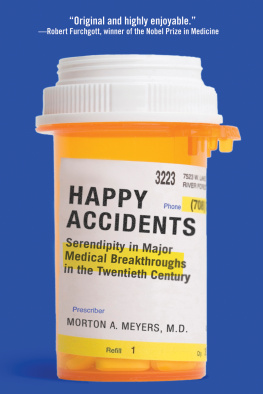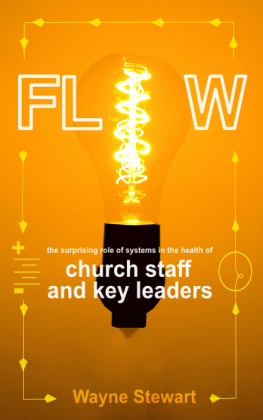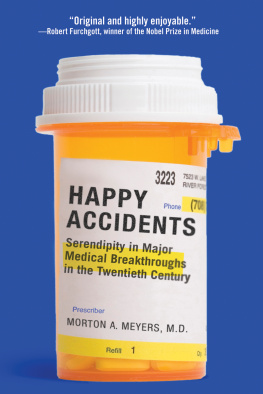HAPPY
ACCIDENTS
HAPPY
ACCIDENTS
Serendipity in Major
Medical Breakthroughs
in the Twentieth Century
MORTON A. MEYERS, M.D.

Arcade Publishing
New York
Copyright 2007, 2011 by Morton A. Meyers
All Rights Reserved. No part of this book may be reproduced in any manner without the express written consent of the publisher, except in the case of brief excerpts in critical reviews or articles. All inquiries should be addressed to Arcade Publishing, 307 West 36th Street, 11th Floor, New York, NY 10018.
Arcade Publishing books may be purchased in bulk at special discounts for sales promotion, corporate gifts, fund-raising, or educational purposes. Special editions can also be created to specifications. For details, contact the Special Sales Department, Arcade Publishing, 307 West 36th Street, 11th Floor, New York, NY 10018 or info@skyhorsepublishing.com .
Arcade Publishing is a registered trademark of Skyhorse Publishing, Inc., a Delaware corporation.
Visit our website at www.arcadepub.com .
10 9 8 7 6 5 4 3 2 1
Library of Congress Cataloging-in-Publication Data is available on file.
ISBN: 978-1-61145-162-7
Printed in the United States of America
To my wife, Bea,
my greatest serendipitous discovery
Contents
PART I:
THE DAWN OF A NEW ERA: INFECTIOUS DISEASES AND
ANTIBIOTICS, THE MIRACLE DRUGS
PART II:
THE SMELL OF GARLIC LAUNCHES THE WAR ON CANCER
PART III:
A QUIVERING QUARTZ STRING PENETRATES
THE MYSTERY OF THE HEART
28. What's Your Number?
PART IV:
THE FLAW LIES IN THE CHEMISTRY, NOT THE CHARACTER:
MOOD-STABILIZING DRUGS, ANTIDEPRESSANTS,
AND OTHER PSYCHOTROPICS
Preface
My God, it moves! I was astonished at what I saw on the X-ray screen. As an academic radiologist, I was trying several years ago to visualize anatomic structures and features never seen before. I was directing my research efforts to the abdominal cavity, the largest potential space in the body, which encloses complex organs and structures. To do this, I introduced liquid contrast material (dye) in volunteers to fill its recesses and outline its contents on X-ray images. Surprisingly, I discovered that the contrast agent spontaneously flowed. Rather than being static and pooling, over time the fluid spread in a specific pattern. I would come to understand that this dynamic circulation was influenced not only by anatomy but also by factors such as gravity and pressures within the abdomen. This serendipitous epiphany provided the stepping-stone to understanding how cancers metastasize to specific remote body sites: cancer cells, shed into the fluid evoked, are carried by the circulating fluid to be deposited at distant sites of pooling. The malignant cells become attached at these points by adhesions and continue to divide to form what is referred to as a secondary deposit, or metastasis. It became clear that the spread of a disease throughout the body is not a random, irrational occurrence but rather follows a predictable pattern. Analysis of a large volume of patient data corroborated this conclusion. This insight regarding cancer was universally adopted and now serves as the basis of modern-day detection and management.
Radiology is a medical specialty in which the trained eye reaps enormous benefits in diagnosis. Every radiologist is certainly familiar with uncovering incidental findings in daily practice that may redirect the course of an investigation. Such a finding is sometimes called a corner-of-the-film diagnosis. Based on a clinical suspicion, an X-ray is requested to search for a specific abnormality, but the results often reveal disease in the periphery of the original area of interest. The value of accidental discoveries is deeply rooted in diagnostic imaging. Indeed, it is the basis upon which the specialty was founded. When Wilhelm Rntgen was experimenting with a cathode-ray tube in 1895, he noticed a fluorescent glow in the darkened room of his laboratory and thought at first that the effect was caused by the sunlight beyond the wooden shutters. Rntgen had made an unexpected discovery: the X-ray. Equally unexpected was the discovery of radioactivity by Henri Becquerel in the following year.
My own serendipitous experience set me on a quest to understand the role of chance in scientific research and its contribution to medical advances in the past century. I was amazed at the findings.
Most people have had at least one experience in which an unintentional action or inadvertent observation, or perhaps even simple neglect, led to a happy outcometo something they could not, or would not, have been able to accomplish even if they had tried. Surprising observations that led to the development of several commercial products have been well described, including champagne, synthetic sweeteners, nylon, the microwave oven, and Post-it notes. In scientific research, such incidents happen all the time, but they have generally been kept secret. In fact, they occur way more often than most researchers care to admit or are even aware of. Accidental discoveries have led to major breakthroughs that today save the lives of millions of people and to drugs and procedures whose names have become household words. Lithium, Viagra, Lipitor, antidepressants, chemotherapy drugs, penicillin and other antibiotics, Coumadinall were discovered not because someone set out to find a specific drug that did a specific thing but because someone found something he or she wasn't even looking for. Similarly, the use of surgical gloves, the Pap smear, and catheterization of the heart's arteries leading to bypass surgery were all stumbled upon.
This is the essence of serendipity. Although the term has become popularized to serve as the synonym for almost any pleasant surprise, it actually refers to searching for something but stumbling upon an unexpected finding of even greater valueor, less commonly, finding what one is looking for in an unexpected way. Discovery requires serendipity. But serendipity is not a chance event alone. It is a process in which a chance event is seized upon by a creative person who chooses to pay attention to the event, unravel its mystery, and find a proper application for it.
Many of the most important breakthroughs in modern medicine have routinely come from unexpected sources in apparently unrelated fields, have often been the work of lone researchers or small close-knit teams operating with modest resources and funding, and have depended crucially on luck, accident, and error. With luck, the essential human factor is sagacity.
While serendipity is essential to discovery, it is nothing without the human beings who know an opportunity when they see one. Lucky accidents or happenstance that could point the way to great discoveries occur every day, but few people recognize them. Successful scientists may have the insight and creativity to recognize a Eureka! moment when it happens, see the potential, and know what to do to take it to the next step.
The scientific literature very rarely reflects this reality. The dominant convention of all scientific writing is to present discoveries as rationally driven and to let the facts discovered speak for themselves. This humble ideal has succeeded in making scientists look as if they never make errors, that they straightforwardly answer every question they investigate. It banishes any hint of blunders and surprises along the way.
Consequently, not only the general public but the scientific community itself is unaware of the vast role of serendipity in medical research. Typically, a discoverer may finally admit this only toward the end of his or her career, after the awards have been received. Memoirs, autobiographies, and Nobel Prize acceptance speeches may reveal the true nature of the discovery. From personal interviews with several Nobel laureates and winners of the prestigious Albert Lasker Award, I have come to understand the factors that have driven many of the critical medical advances of the twentieth century.
Next page









